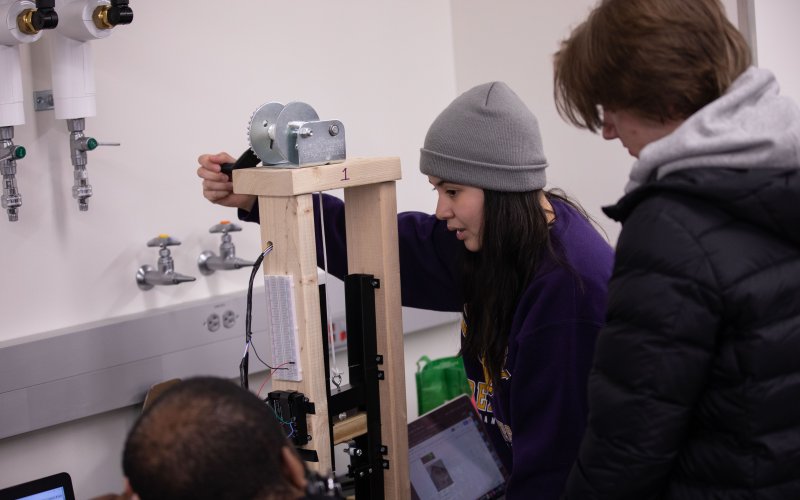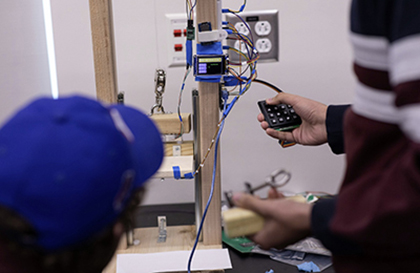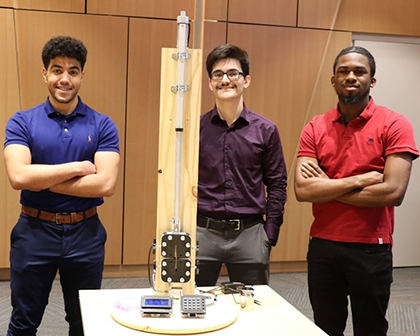Engineering Students Take on Chemistry Challenge

ALBANY, N.Y. (May 10, 2022) — When UAlbany Chemistry Associate Professor Alan Chen and Assistant Professor Jeremy Feldblyum set about preparing to equip a new Polymer Chemistry lab course, they were faced with a hurdle. Feldblyum, located within UAlbany’s recently opened ETEC facility’s materials chemistry wing, wanted students in his Polymer Chemistry course to have force tensiometers — a device capable of accurately testing the strength properties of new materials.
Synthetic polymers, from Styrofoam to Kevlar, are ubiquitous across all industries. The ability to accurately measure the tensile strength is a critical step in the process of developing new materials.
With prices of tensiometers running from tens to hundreds of thousands of dollars, Chen and Feldblyum would have to come up with an economical solution if they wanted to provide the opportunity for as many chemistry students as possible to have hands-on experience operating these machines.
They turned to the College of Engineering and Applied Sciences (CEAS) to determine if the departments could work together to develop a solution. Chen reached out to Electrical and Computer Engineering Professor of Practice Jonathan Muckell, as both were leading freshmen Living-Learning Communities and had been brainstorming ways chemistry and engineering students could work together. With Muckell scheduled to teach Systems Analysis and Design in Spring 2022, a plan was hatched.

Chen and Feldblyum provided schematics for a low-cost D.I.Y. tensiometer from a recent research paper that utilized off-the-shelf electronic components. It was then up to Muckell and his students to improve upon the design and make accurate, reliable, and easy-to-use versions suitable for a Chemistry teaching lab. To encourage the best real-world designs, the students engaged in a friendly class competition in which the top design would be replicated and used to equip the new polymers lab.
Over the course of the semester, 37 students in Muckell’s course set about analyzing the problem based on the chemistry department’s requirements, evaluating multiple design alternatives, and then implementing, testing and documenting their improved system designs and experimental results.
In the final judging from late April, the top four teams each gave detailed presentations and live demonstrations of their prototypes to a packed audience of students and faculty from ECE and Chemistry and distinguished guests College of Arts and Sciences Dean Jeanette Altarriba, Chemistry Chair Alex Shekhtman, and ECE Chair Gary Saulnier.
Judges from the Chemistry Department and RNA Institute selected the best design and awarded the top teams handmade trophies that were hand-crafted by "World of Chemistry" undergraduate students by reducing silver nitrate to form silver coatings on the interior of chemistry glassware.
"This project has been an integral part of my college experience thus far." said electrical and computer junior Youssef Jalwaj-Soubai, a member of the first-place team whose solution made use of a linear actuator arm that is commonly found in garage door openers and solar panel systems.

“This event went better than I had could have ever hoped,” said Chen. “Although the top teams all demonstrated ingenuity in incorporating novel features like touchscreens, auto-calibration mechanisms, and easy-to-use data graphing apps, the first-place team really stood out because they came up with a completely different design that is superior in every way from the schematics we initially provided. In other words, they figured out how to deliver a product that was even better than we knew to ask for, all on a shoestring budget of 150 dollars."
Muckell expects that a small team of engineering seniors, as part of their capstone course, will integrate the best features from the top designs, build about a dozen units, and equip the new chemistry department polymer lab next year.
"These instruments will really make a huge difference for our students," said Feldblyum. "Tensile testing is one of the pillars of materials chemistry. It tells us how rigid a polymer is and how far it can stretch before breaking. Giving our students the opportunity to have hands-on experience in not only synthesizing polymers but also characterizing how different compositions lead to different mechanical properties will help prepare them for roles across the materials and polymer industries.”




